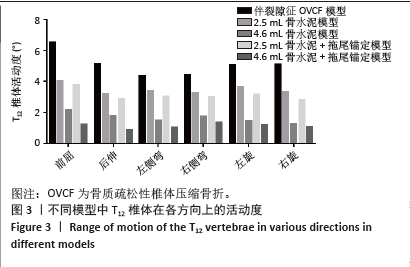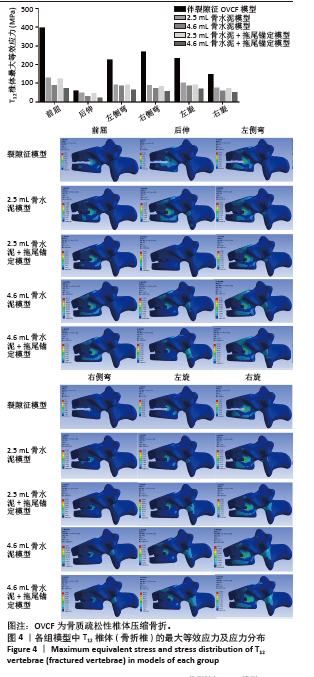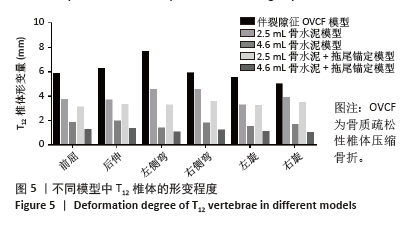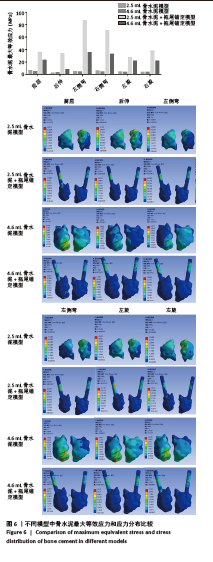[1] 冯骁骁, 吕南宁, 张浩, 等. 低温与常温灌注椎体成形术治疗Kümmell病[J]. 中国矫形外科杂志,2023,31(11):980-985.
[2] ROUSING R, KIRKEGAARD AO, NIELSEN M, et al. Percutaneous vertebroplasty as treatment of malignant vertebral lesions: a systematic review and GRADE evaluation resulting in a Danish national clinical guideline. Eur Spine J. 2020;29(7):1573-1579.
[3] ANDREÃO FF, BORGES P, PALAVANI LB, et al. Percutaneous Vertebroplasty versus Nonoperative Treatment of Osteoporotic Vertebral Fractures: A Meta-Analysis of Randomized Controlled Trials. World Neurosurg. 2024;190:408-421.e5.
[4] 邝冠明, 高庆鹏, 杨震宇, 等. 经皮椎体成形术/经皮椎体后凸成形术治疗超高龄患者椎体压缩骨折的疗效和安全性初步研究[J]. 中华骨与关节外科杂志,2020,13(12):982-986.
[5] 王勤业, 方芳, 常小波. 经皮椎体成形术后骨水泥渗漏的危险因素分析[J]. 中国骨与关节损伤杂志,2024,39(3):288-291.
[6] YU W, XIAO X, ZHANG J, et al. Cement Distribution Patterns in Osteoporotic Vertebral Compression Fractures with Intravertebral Cleft: Effect on Therapeutic Efficacy. World Neurosurg. 2019;123:e408-e415.
[7] 许勇, 官众, 李永霞, 等. 骨填充网袋治疗老年骨质疏松性压缩骨折合并椎体内裂隙征[J]. 中国组织工程研究,2019,23(10): 1477-1482.
[8] 路文超, 王宇鹏, 湛川. 椎体后凸成形治疗Kummell病过程中发生的骨水泥渗漏[J]. 中国组织工程研究,2019,23(2):172-177.
[9] 庞巨涛, 张新虎, 孙建华, 等. 经皮球囊扩张椎体后凸成形后椎体再骨折的危险:回顾性多因素分析[J]. 中国组织工程研究,2019, 23(8):1182-1187.
[10] LV NN, HOU MZ, ZHOU ZZ, et al. Does the Relationship Between Bone Cement and the Intravertebral Cleft of Kummell Disease Affect the Efficacy of PKP. World Neurosurg. 2022;160:e430-e435.
[11] 李永军, 梁永辉, 韦兴, 等. “拖尾征”锚定骨水泥椎体后凸成形术对Kummell’s病的治疗效果[J]. 中华老年多器官疾病杂志,2020, 19(7):494-498.
[12] 陈乃旺, 任国帅, 庄青山, 等. 提高骨水泥注入安全性的改良椎体成形术[J]. 中国矫形外科杂志,2023,31(8):738-741.
[13] YONEZAWA N, YONEZAWA Y, NISHIMURA T, et al. Vertebra-Pediculoplasty: A New Approach to Treatment of Split-Type and Delayed-Union Osteoporotic Vertebral Fracture with a Risk of Cement Dislodgement. World Neurosurg. 2021;155:e55-e63.
[14] GUO HZ, ZHANG SC, GUO DQ, et al. Influence of cement-augmented pedicle screws with different volumes of polymethylmethacrylate in osteoporotic lumbar vertebrae over the adjacent segments: a 3D finite element analysis. BMC Musculoskelet Disord. 2020;21(1):460.
[15] GUO HZ, TANG YC, GUO DQ, et al. Biomechanical evaluation of four different posterior instrumentation techniques for single-level transforaminal lumbar interbody fusion: a finite element analysis. Am J Transl Res. 2020;12(10):6160-6169.
[16] 李光晟, 吴如陈, 刘成招, 等. 椎弓根骨水泥锚定对椎体成形术治疗Kümmell’s病骨水泥团块稳定作用的有限元分析[J]. 中国脊柱脊髓杂志,2023,33(9):823-830.
[17] 曾锦源, 谢昀, 陈春永, 等. 骨折复位程度和骨水泥注入量对PKP术后邻近椎体应力影响的有限元分析[J]. 中国骨与关节损伤杂志, 2023,38(7):698-702.
[18] LUO C, JIANG T, TIAN S, et al. Finite element analysis of lumbar spine with different backpack positions in parachuting landing. Comput Methods Biomech Biomed Engin. 2021;24(15):1679-1686.
[19] 魏源标, 郭惠智, 张顺聪. 皮质骨轨迹螺钉固定对相邻节段影响的有限元分析[J]. 中国组织工程研究,2021,25(18):2799-2804.
[20] 费琦, 赵凡, 杨雍, 等. 腰椎后路融合手术对失稳模型节段稳定性及相邻节段力学的影响[J]. 中华医学杂志,2015,95(45):3681-3686.
[21] FAN R, LIU J, LIU J. Prediction of the natural frequencies of different degrees of degenerated human lumbar segments L2-L3 using dynamic finite element analysis. Comput Methods Programs Biomed. 2021;209:106352.
[22] ZHANG X, CHEN T, MENG F, et al. A finite element analysis on different bone cement forms and injection volumes injected into lumbar vertebral body in percutaneous kyphoplasty. BMC Musculoskelet Disord. 2022;23(1):621.
[23] MONDAL S, MACMANUS DB, BANCHE-NICLOT F, et al. Finite element analysis of vertebroplasty in the osteoporotic T11-L1 vertebral body: Effects of bone cement formulation. J Biomed Mater Res B Appl Biomater. 2024;112(1):e35359.
[24] 史晓林, 刘康. 老年性骨质疏松症中西医结合诊疗指南[J]. 中国骨质疏松杂志,2024,30(7):937-946.
[25] 林杰, 金甬, 庞清江. 胃肠道菌群与骨质疏松症关系的研究进展[J]. 中国临床解剖学杂志,2024,42(1):109-111.
[26] 马一鸣, 王子豪, 蔡大钊, 等. 椎体后凸成形治疗骨质疏松性椎体压缩骨折后新发骨折危险因素预测模型的建立[J]. 中国组织工程研究,2023,27(23):3700-3706.
[27] 中华医学会骨质疏松和骨矿盐疾病分会, 章振林. 原发性骨质疏松症诊疗指南(2022)[J]. 中国全科医学,2023,26(14):1671-1691.
[28] BROWN JP, ENGELKE K, KEAVENY TM, et al. Romosozumab improves lumbar spine bone mass and bone strength parameters relative to alendronate in postmenopausal women: results from the Active-Controlled Fracture Study in Postmenopausal Women With Osteoporosis at High Risk (ARCH) trial. J Bone Miner Res. 2021;36(11): 2139-2152.
[29] 孙亦强, 王秀双, 李建军, 等. 椎体内裂隙征引起的椎体动态不稳与神经功能损伤的关系[J]. 中国组织工程研究,2020,24(18): 2900-2905.
[30] QI H, QI J, SUN Y, et al. Bone microarchitecture and metabolism in elderly male patients with signs of intravertebral cleft on MRI. Eur Radiol. 2022;32(6):3931-3943.
[31] DONG L, DONG C, ZHU Y, et al. Intravertebral cleft in pathological vertebral fracture resulting from spinal tuberculosis: a case report and literature review. BMC Musculoskelet Disord. 2020;21(1):619.
[32] FAN N, WANG T, WANG A, et al. A predictive nomogram for intradiscal cement leakage in percutaneous kyphoplasty for osteoporotic vertebral compression fractures combined with intravertebral cleft. Front Surg. 2022;9:1005220.
[33] LV N, FENG X, LIU H, et al. Study on the influence of balloon dilation mode on the intravertebral cleft of osteoporotic fracture. BMC Surg. 2022;22(1):351.
[34] ZHANG T, KANG Y, WANG Y, et al. Does segmental artery occlusion cause intravertebral cleft following osteoporotic vertebral fracture: a prospective magnetic resonance angiography study. BMC Musculoskelet Disord. 2022;23(1):103.
[35] TANG S, FU W, ZHANG H, et al. Efficacy and Safety of High-Viscosity Bone Cement Vertebroplasty in Treatment of Osteoporotic Vertebral Compression Fractures with Intravertebral Cleft. World Neurosurg. 2019;132:e739-e745.
[36] ZHANG S, CHEN H, BAO L, et al. Association Between Spinopelvic Parameters and Intravertebral Cleft in Osteoporosis Vertebral Compression Fractures. World Neurosurg. 2024;183:e813-e817.
[37] YONEZAWA Y, YONEZAWA N, KANAZAWA Y, et al. Revision balloon kyphoplasty and vertebra-pediculoplasty using cannulated screws for osteoporotic vertebral fractures with cement dislodgement following conventional balloon kyphoplasty. J Neurointerv Surg.2022;14(8): 844-846.
[38] WANG B, ZHAN Y, BAI Y, et al. Biomechanical analysis of a novel bone cement bridging screw system for the treatment of Kummell disease: a finite element analysis. Am J Transl Res. 2022;14(10): 7052-7062.
[39] WANG B, WANG Y, ZHAO Q, et al. Pediculoplasty combined with vertebroplasty for the treatment of Kummell’s disease without neurological impairment: robot-assisted and fluoroscopy-guided. Am J Transl Res. 2020;12(12):8019-8029.
[40] LI C, SONG L, XIAO J, et al. Second-generation bone cement-injectable cannulated pedicle screws for osteoporosis: biomechanical and finite element analyses. J Orthop Surg Res. 2023;18(1):343.
[41] ZHANG G, LI J, ZHANG L, et al. Biomechanical Effect of Different Posterior Fixation Techniques on Stability and Adjacent Segment Degeneration in Treating Thoracolumbar Burst Fracture With Osteoporosis: A Finite Element Analysis. Spine (Phila Pa 1976). 2024; 49(15):E229-E238.
|



